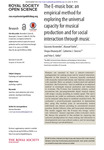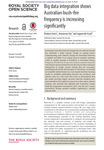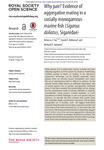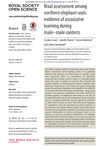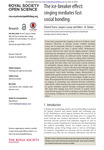Education: Recent submissions
Now showing items 581-600 of 806
-
Intricate predatory decisions by amosquito-specialist spider from Malaysia
(The Royal Society, 2014)Paracyrba wanlessiis a southeast Asian jumping spider (Salticidae) that lives in the hollow internodes of fallen bamboo and preys on the larvae, pupae and adults of mosquitoes. In contrast to Evarcha culicivora, an East ... -
Evidence for a bimodal distribution of hybrid indices in a hybrid zone with high admixture
(The Royal Society, 2015)The genetic structure of a hybrid zone can provide insights into the relative roles of the various factors that maintain the zone. Here, we use a multilocus approach to characterize a hybrid zone between two subspecies of ... -
The E music box
(The Royal Society, 2015)Humans are assumed to have a natural universal predisposition for making music and for musical interaction. Research in this domain is, however, typically conducted with musically trained individuals, and therefore confounded ... -
Using prediction markets to forecast research evaluations
(The Royal Society, 2015)The 2014 Research Excellence Framework (REF2014) was conducted to assess the quality of research carried out at higher education institutions in the UK over a 6 year period. However, the process was criticized for being ... -
Light-emitting diode street lights reduce last-ditch evasivemanoeuvres by moths to bat echolocation calls
(The Royal Society, 2015)The light-emitting diode (LED) street light market is expanding globally, and it is important to understand how LED lights affect wildlife populations. We compared evasive flight responses of moths to bat echolocation calls ... -
Enabling quaternion derivatives
(The Royal Society, 2015)Quaternion derivatives exist only for a very restricted class of analytic (regular) functions however, in many applications, functions of interest are real-valued and hence not analytic, a typical case being the standard ... -
Can outcomes of dyadic interactions be consistent across contexts amongwild zebrafish?
(The Royal Society, 2015)Winner–loser relations among group-living individuals are often measured by the levels of aggressive interactions between them. These interactions are typically driven by competition for resources such as food and mates. ... -
Big data integration shows Australian bush-fire frequency is increasing significantly
(The Royal Society, 2016)Increasing Australian bush-fire frequencies over the last decade decision sciencehas indicated a major climatic change in coming future. Understanding such climatic change for Australian bush-fire is limited and there is ... -
On alternative wavelet reconstruction formula: a case study of approximate wavelets
(The Royal Society, 2014)The application of the continuous wavelet transform to the study of a wide class of physical processes with oscillatory dynamics is restricted by large central frequencies owing to the admissibility condition. We propose ... -
Why pair? Evidence of aggregativemating in a sociallymonogamous marine fish
(The Royal Society, 2015)Many species live in stable pairs, usually to breed and raise offspring together, but this cannot be assumed. Establishing whether pairing is based on mating, or an alternative cooperative advantage, can be difficult, ... -
Rival assessment among northern elephant seals
(The Royal Society, 2015)Specialized signals emitted by competing males often convey honest information about fighting ability. It is generally believed that receivers use these signals to directly assess their opponents. Here, we demonstrate an ... -
A process of rumour scotching on finite populations
(The Royal Society, 2015)Rumour spreading is a ubiquitous phenomenon in social and technological networks. Traditional models consider that the rumour is propagated by pairwise interactions between spreaders and ignorants. Only spreaders are active ... -
Greater magnocellular saccadic suppression in high versus low autistic tendency suggests a causal path to local perceptual style
(The Royal Society, 2015)Saccadic suppression—the reduction of visual sensitivity during rapid eye movements—has previously been proposed to reflect a specific suppression of the magnocellular visual system, with the initial neural site of that ... -
Object localization using a biosonar beam
(The Royal Society, 2015)Determining the location of a sound source is crucial for survival. Both predators and prey usually produce sound while moving, revealing valuable information about their presence and location. Animals have thus evolved ... -
Self organized flexible leadership promotes collective intelligence in human groups
(The Royal Society, 2015)Collective intelligence refers to the ability of groups to outperform individual decision-makers. At present, relatively little is known about the mechanisms promoting collective intelligence in natural systems. We here ... -
Escaping the tragedy of the commons through targeted punishment
(The Royal Society, 2015)Failures of cooperation cause many of society’s gravest problems. It is well known that cooperation among many players faced with a social dilemma can be maintained thanks to the possibility of punishment, but achieving ... -
The ice breaker effect
(The Royal Society, 2015)It has been proposed that singing evolved to facilitate social cohesion. However, it remains unclear whether bonding arises out of properties intrinsic to singing or whether any social engagement can have a similar effect. ... -
Social dominance modulates eavesdropping in zebrafish
(The Royal Society, 2015)Group living animals may eavesdrop on signalling interactions between conspecifics and integrate it with their own past social experience in order to optimize the use of relevant information from others. However, little ... -
To the non-local theory of cold nuclear fusion
(The Royal Society, 2014)In this paper, we revisit the cold fusion (CF) phenomenon using the generalized Bolzmann kinetics theory which can represent the non-local physics of this CF phenomenon. This approach can identify the conditions when the ... -
The Adventure of Physics - Vol. IV: The Quantum of Change
(Olympiadis trigesimae primae, 2016)Chapter 1: Minimum action - quantum theory for poets. Chapter 2: Light - the strange consequences of the quantum of action. Chapter 3: Motion of matter - beyond classical physics. Chapter 4: The quantum description of ...



